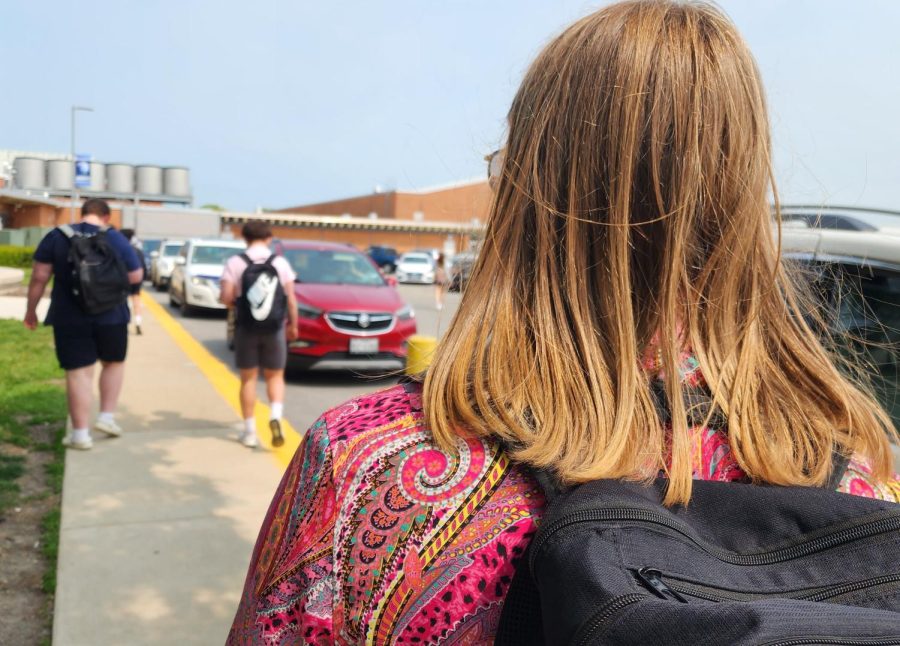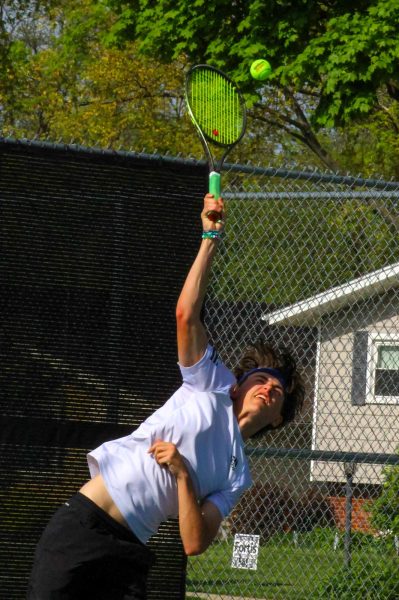For we walk by faith, not by sight
I’m walkin’ here!
May 18, 2023
In the mornings of my junior year, a silver blonde, bob cut haired woman, maybe in her 60s, would stand on the corner of Highland and Prospect Manor. She interacted with the students traversing to school and relaxed by reading her book in the cool morning breeze.
When I say interact, I mean scream at and attempt to, pitifully, chase down cars who would dare go above the speed limit while in her presence, whilst also ignoring the existence of all walkers and bikers getting by.
And when I say relax, I mean casually reading through the convoluted text that is Christianity’s holy Bible.
“He will wipe away every tear from their eyes, and death shall be no more, neither shall there be mourning, nor crying, nor pain anymore, for the former things have passed away”(Revelation 21:4).
Truly riveting stuff.
Back in the olden days, when our parents would traverse through miles of jungle, chopping through vines and overgrown foliage just to get to their little one-room schoolhouses, walking was more of a norm. But today, walking to school has been pushed aside.
According to the 2021 CDC report, in 61.7% of schools, fewer than 10% of students walked or biked to school, a significant decline from 48% in 1969. This could be due to multiple factors.
Schools used to be centrally located in communities, but now over ¾ of American students live a mile or more from their school and that number has only increased in the past decades. Passed in 1977, the U.S. Federal Motor Vehicle Safety Standards for School Buses act made school buses safer, both outside by requiring additional emergency exits and more crumple zones, which are areas of the bus built to collapse in order to protect its passengers, and inside the vehicle by providing crash protection seating without the need for a child to buckle up.
These changes led to a ramp up of bus production, making it a more accessible and convenient option for students and helped parents worry slightly less about the location of their home.
Walking to school just may have been a fad overstaying its time, but after four years at Prospect, having walked to school almost daily due to hard working parents, I believe more people should try it.
Walking means you do not need to ride in the giant, vape filled, tin can on wheels that people call school buses, or rely on your friend with a parking pass to show up on time, and although there are the “eccentric” neighbors, the majority of them are friendly and willing to say hi.
Walking’s physical activity not only helps prevent childhood obesity, promotes a healthy mind, and supports healthy bones, but a 2015 study done by goDCgo, showed 20 minutes of physical activity, or roughly one mile of walking, increased test scores in reading and math.
One potential worry about walking to school is the possibility of being late for the first period.
“There is bus transportation available to people, so if they are choosing to walk instead, that is a choice they made,” said social sciences teacher Michael Sebestyen on first period attendance. “You have to encourage them to get themselves moving to school earlier.”
Time management is an important life skill which is learned through walking to school and prepares you for the rest of your life. Weather and traffic can be prepared for or avoided and anywhere is walking distance if you time it correctly.
Out of the school walkers I talked to, nobody had an issue getting to school on time for their first period classes and a survey of 90 school walkers showed that 64.4% of students walked less than 20 minutes to get to school.
There is no need to worry about being late and most days the outdoors serve as a great place to clear your head and reduce stress before the school day begins. Psychology teacher Tina Mrs. Athanasopoulos explained how exposure to the outdoors reduces stress by increasing serotonin levels and lowering stress-hormones like cortisol.
Most days.
We are adjacent to the windy city after all, where, according to World and Climate, on average, over a ⅓ of days in a year have either rain, hail, or snow and the driest of days occur in the months where students are out of school.
Even then, the weather is manageable and you learn ways to get through it.
It took me falling on my Bible word for donkey after slipping on the icye sidewalks countless times for my single-celled monkey brain to realize walking on the snow-covered grass provides you with more friction. And parkouring through the rainy puddles can be fun and intense, be it with soggy socks.
However, the weather in combination with student drivers can be problematic.
“You wouldn’t believe the people they let on the roads,” said regular school walker and senior Vito Abromaitis. “I’ve almost been run over many times.”
Inexperienced drivers and unsafe road conditions caused by weather is a combination that could lead to tragedy.
According to Safe Kids Worldwide, on average there are five teen pedestrian deaths each week along with almost 500 injuries. In particular, high school students are involved in more than half of these incidents while accounting for only 26% of the American student population.
However, drivers are not entirely at fault. According to Safe Kids Worldwide, an organization dedicated to the protection of students from various accidents, distracted walking was found in ¼ of these incidents, with 44% of students wearing headphones and 31% on their phones.
Walkers can help decrease these incidents simply by educating themselves and parents on dangerous walking habits. High risk traffic areas can be identified, technology distractions can be lowered, students can be made more aware of traffic signs and signals, and a study done by Rutgers University showed the earlier in a person’s life these lessons are taught, the more likely they are to continue these actions going forward.
We are fortunate to be surrounded by generally safe neighborhoods, with well kept, tree-lined sidewalks that not only make walking to school more pleasant, but safer as well.
In a perfect world, people would be able to transport instantaneously to school via teleportation. However, this is not a perfect world. It has alligators.
So, walking is a healthy option to get to school and, especially if you live close and still drive (talking to you driver of orange Dodge Dart), more people should at least try it.
And remember, if you don’t look both ways before you cross the road, just know you are one step closer to Jesus.























































































Judith • May 18, 2023 at 7:41 pm
I walked to grammar school 3 blocks and once she turned five had to pull my sister along saying she was harder to pull than one giraffe , two monkeys, three ostriches etc etc etc till we got to school. Annoyed yes but it is a favorite memory now. I and then both of us walked to and from Roosevelt High to save bus money. I recited Latin verbs etc she algebra equations. Good memories of being together
Excellent article Ethan with humor and amusing/interesting anecdotes